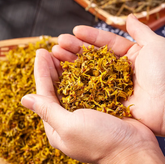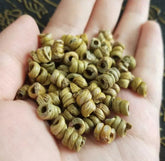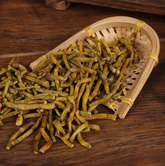Snow lotus from Tianshan Mountains - One of the Nine Noble Herbs
Saussurea involucrata is a member of the genus Saussurea within the Asteraceae family. This perennial herb typically reaches heights of 15 to 35 centimeters (6 to 14 inches). It has a thick root system, and its base is often covered with numerous brown, withered leaves. The stem is hairless (glabrous) and measures about 2 to 3 centimeters in diameter at the base. The leaves are oval to ovate-elliptic in shape, measuring up to 14 centimeters long and 2 to 3.5 centimeters wide. Both leaf surfaces are smooth and hairless. The uppermost bracts are membranous and broad-ovate, measuring 5.5 to 7 centimeters long and 2 to 7 centimeters wide. The flower head (capitulum) forms at the stem's apex and is purple in color. It produces oblong achenes with a dirty-white pappus.
Its distribution spans high-altitude regions of China, including Xinjiang, Gansu, and Qinghai, as well as parts of Russia and Kazakhstan. It thrives in the high-altitude zones of mountain ranges like the Tianshan and Kunlun Mountains. This plant is highly cold-tolerant and inhabits extreme environments such as rocky mountain slopes, cliff crevices, and alpine valleys at elevations of 2,400 to 4,100 meters (7,900 to 13,500 feet). These habitats are characterized by freezing temperatures, low oxygen levels, nutrient-poor soils, and intense ultraviolet radiation.
Across various cultures, the Tianshan Snow Lotus is revered as a symbol of purity, resilience, and noble spirit. Its ability to grow and flower under extreme conditions represents remarkable vitality and an indomitable spirit. In Kazakh culture, it is considered a supreme token of love, symbolizing purity and steadfast devotion.
In Traditional Chinese Medicine (TCM), the entire Saussurea involucrata plant is used medicinally. It is considered warm in nature, with a sweet and bitter taste, and is believed to act upon the Liver, Spleen, and Kidney meridians. Its traditional functions include dispelling cold, warming and strengthening Yang, regulating menstruation, and stopping bleeding.
Modern research has identified various bioactive compounds in Snow Lotus , including flavonoids, alkaloids, phenylpropanoids, sesquiterpenes, volatile oils, steroids, and polysaccharides.
Due to its high medicinal value, wild Tianshan Snow Lotus has suffered from overharvesting. Compounding this threat is its slow growth rate; it typically requires at least 6 to 8 years to reach flowering and fruiting maturity. Consequently, wild populations of Saussurea involucrata have become increasingly scarce. Furthermore, tourism development has degraded its natural habitat. In China, it is listed as a National Second-Class Protected Wild Plant. Conservation measures include establishing protected cultivation bases in Xinjiang, implementing a quota collection system, and enforcing designated no-harvest periods and seasonal closures.
- Choosing a selection results in a full page refresh.







